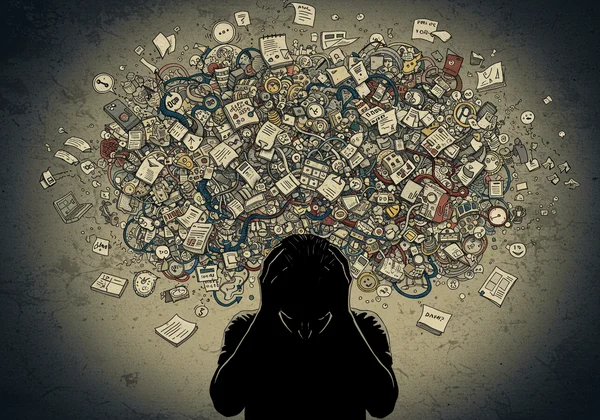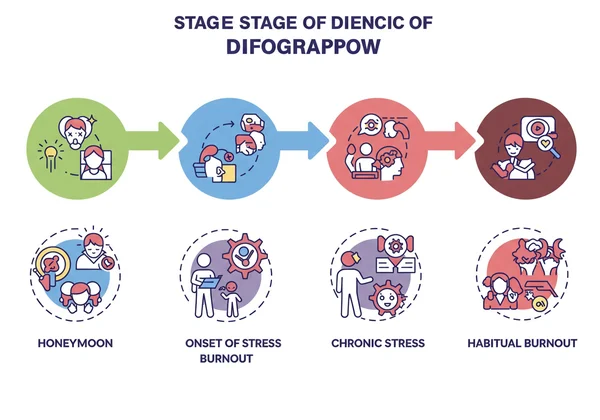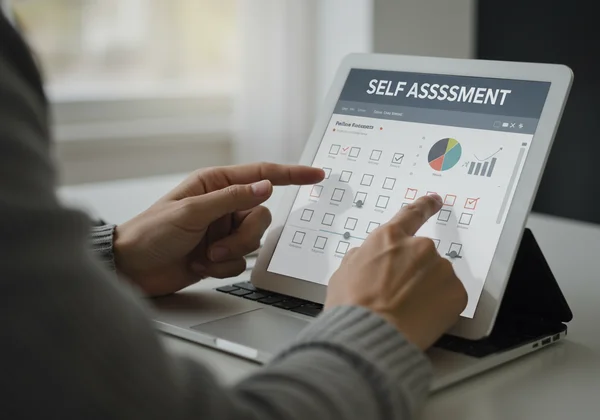The 5 Stages of Burnout: A Self-Assessment Guide
Feeling overwhelmed, drained, or just perpetually "off"? You might be experiencing more than just a tough week at work. Burnout is a gradual process that can quietly creep into your life, leaving you feeling exhausted, cynical, and ineffective. But here's the empowering truth: understanding its progression is the first crucial step toward taking effective action. What are the five stages of burnout? This guide will walk you through each phase, from the earliest warning signs to deep-seated exhaustion, helping you recognize where you are and what to do next.
Burnout isn't a sign of weakness; it's a response to prolonged, overwhelming stress. Identifying your position on this spectrum is vital for recovery. While reading this guide is a great start, getting a personalized snapshot of your situation through an online burnout assessment can provide the clarity you need to move forward.

Understanding the Burnout Cycle: More Than Just Being Tired
Many people mistake burnout for simple stress, but they are fundamentally different. While stress is characterized by over-engagement and a sense of urgency, burnout is defined by disengagement and a feeling of emptiness. It’s the result of chronic workplace stress that has not been successfully managed. Recognizing this distinction is key to addressing the root cause of your feelings.
What is Burnout, Really? Defining the Core Experience
As a psychological concept, burnout isn't just about feeling tired. It's a specific state of emotional, physical, and mental exhaustion. Researchers like Christina Maslach define it through three core dimensions:
- Exhaustion: A profound sense of being emotionally drained and physically depleted. You feel you have nothing left to give.
- Cynicism or Depersonalization: A growing emotional distance from your job. You might feel detached, negative, or callous toward your work, projects, and colleagues.
- Reduced Professional Efficacy: A feeling of incompetence and a lack of achievement. You begin to doubt your ability to make a difference, and your productivity suffers.
Burnout vs. Stress: Knowing the Key Differences
Are you stressed or burnt out? Stress often involves a sense of hyperactivity and urgency—too much pressure, too many demands. You still believe that if you can just get everything under control, you'll feel better. Burnout, on the other hand, is about feeling you have nothing left. It’s characterized by helplessness, emotional blunting, and a loss of motivation. Stress can feel like you're drowning in responsibility, while burnout feels like you're already dried up.
The 5 Stages of Burnout: From Honeymoon to Habitual Burnout
Burnout unfolds over time. By understanding these five stages, you can identify early warning signs and intervene before reaching a critical point. See if any of these resonate with your own experience.

Stage 1: The Honeymoon Phase – High Hopes & Initial Engagement
When you start a new job or take on a new project, you often experience a period of high energy, commitment, and job satisfaction. This is the Honeymoon Phase. You readily accept challenges and pour your energy into your work. However, the seeds of future burnout can be sown here if you develop work patterns and coping mechanisms—like taking on too much or sacrificing self-care—that are ultimately unsustainable.
Stage 2: Onset of Stress – Early Warning Signs Emerge
In this stage, your initial optimism begins to wane. You start to notice that some days are more difficult than others. The awareness of stress becomes more prominent, and you may experience early, subtle symptoms like irritability, difficulty concentrating, or a decline in sleep quality. Physical signs such as headaches or fatigue might become more frequent. This is the first signal that your work-life balance and coping strategies need attention.
Stage 3: Chronic Stress & Persistent Symptoms
The stress is no longer occasional; it's a persistent part of your daily life. The symptoms from the previous stage become more intense and regular. You might feel a marked drop in motivation, start procrastinating more, or feel consistently pressured and overwhelmed. A sense of urgency turns into a feeling of being perpetually behind. Many people first realize something is seriously wrong during this stage and might consider seeking a Job Burnout Test for answers.
Stage 4: Full-Blown Burnout & Emotional Exhaustion
This is the critical stage where the symptoms become severe and undeniable. The core dimensions of burnout are in full effect. You feel deep emotional exhaustion, pervasive cynicism, and a sense of detachment from your life. It becomes difficult to cope with daily tasks, and your work performance noticeably suffers. A feeling of being trapped or empty is common, and physical symptoms can become chronic and more serious.

Stage 5: Habitual Burnout – The Disengagement Phase
At this final stage, burnout has become so embedded in your life that it feels like the new normal. The symptoms are chronic, and you may experience a sense of profound sadness or emotional numbness. This stage can put you at significant risk for developing depression or anxiety disorders. You may feel a deep loss of your professional and personal identity, making it feel impossible to see a way out.
How to Identify Your Current Burnout Stage
Recognizing yourself in the stages above is the first step. Now, it's time to connect that knowledge to your personal experience and get a clearer, more objective understanding of your risk level.
Reflecting on Your Experiences: Key Questions to Ask
Take a moment for honest self-reflection. Ask yourself the following questions to help pinpoint where you might be on the burnout spectrum:
- How has my energy for work changed over the last six months?
- Do I feel more cynical or negative about my job than I used to?
- Am I having trouble feeling proud of my accomplishments?
- Do I feel emotionally drained or detached from my colleagues and tasks?
- Is my sleep, appetite, or overall mood consistently poor?
Why a Burnout Self-Assessment is Your First Step
While self-reflection is powerful, a structured assessment provides an objective framework for your feelings. A reliable Burnout Test uses research-backed questions to measure the key dimensions of burnout, giving you a clear, data-driven snapshot of your situation. It removes the guesswork and self-doubt. Taking a confidential, science-based test is the most effective first step toward gaining actionable insights. Ready to see where you stand? You can take a free burnout test right now.

Beyond the Stages: Taking Action Towards Recovery
Recognizing the five stages of burnout is not about labeling yourself; it's about empowering yourself with a map. This map shows you where you are, where you've been, and most importantly, how to change direction. Burnout is not a permanent state. It is a signal that something in your work life needs to change.
By understanding your personal situation, you can begin to implement targeted strategies for recovery, whether that means setting better boundaries, seeking support from your manager, or focusing on restorative self-care. The journey back from burnout starts with a single, informed step.
Ready to understand your personal situation? Start your assessment on our homepage for free, confidential results and take the first step toward a healthier, more balanced work life.
Frequently Asked Questions About Burnout Stages
What are the five stages of burnout?
The five commonly recognized stages of burnout are: 1. The Honeymoon Phase (high satisfaction, but unsustainable habits form), 2. Onset of Stress (early signs of physical and mental fatigue), 3. Chronic Stress (persistent stress and declining motivation), 4. Burnout (severe symptoms of exhaustion and cynicism), and 5. Habitual Burnout (burnout becomes the norm and is deeply embedded).
What does burnout fatigue feel like?
Burnout fatigue is more than just feeling sleepy. It's a profound, bone-deep exhaustion that isn't relieved by a good night's sleep. It can feel like a complete depletion of your physical and emotional energy, making even small tasks feel monumental. This sense of being "drained" or "empty" is a core symptom of burnout.
What can burnout be mistaken for?
Burnout is often mistaken for stress, laziness, or depression. While it shares symptoms with depression (like fatigue and low mood), burnout is specifically tied to one's work context. It can also be confused with laziness because of the associated drop in motivation and productivity, but it stems from exhaustion, not a lack of will. A focused occupational burnout test can help differentiate it from other issues.
Is it burnout or am I just lazy?
This is a common question born from self-doubt. Laziness is typically a reluctance to exert oneself without an underlying cause of exhaustion. Burnout, however, is a state of inability caused by prolonged stress. If you once had passion and motivation for your work but now feel too exhausted and cynical to care, you are likely experiencing burnout, not laziness.
How do you test for burnout?
You can test for burnout using a validated self-assessment tool. The most credible tools, like our free burnout test, are based on established psychological principles like the Maslach Burnout Inventory (MBI). These tests ask a series of questions about your feelings toward your work to measure your levels of exhaustion, cynicism, and professional efficacy. Taking an online burnout test provides a quick, confidential, and scientifically-grounded way to assess your risk.